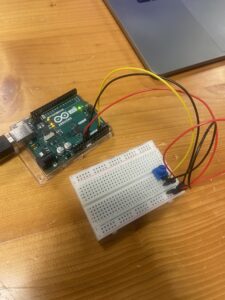Exercise 1
let rVal = 0;
let potentiometerInput = 0;
let circleX;
function setup() {
createCanvas(640, 480);
textSize(18);
circleX = width/2;
}
function draw() {
// one value from Arduino controls the background's red color
background(255);
// the other value controls the text's transparency value
if (!serialActive) {
text("Press Space Bar to select Serial Port", 20, 30);
} else {
text("Connected", 20, 30);
// Print the current values
text('potentiometerInput = ' + str(potentiometerInput), 20, 70);
}
//Draws the circle
circle(circleX,height/2,100);
}
function keyPressed() {
if (key == " ") {
// important to have in order to start the serial connection!!
setUpSerial();
}
}
// This function will be called by the web-serial library
// with each new line of data. The serial library reads
// the data until the newline and then gives it to us through
// this callback function
function readSerial(data) {
////////////////////////////////////
//READ FROM ARDUINO HERE
////////////////////////////////////
if (data != null) {
// make sure there is actually a message
// split the message
let fromArduino = split(trim(data), ",");
// if the right length, then proceed
if (fromArduino.length == 1) {
// only store values here
// do everything with those values in the main draw loop
// We take the string we get from Arduino and explicitly
// convert it to a number by using int()
// e.g. "103" becomes 103
potentiometerInput = int(fromArduino[0]);
//Maps the potentiometer input value to the width of the canvas.
circleX = map(potentiometerInput,0,1023,0,width);
}
let sendToArduino = "\n";
writeSerial(sendToArduino);
}
}
P5 ⬆️
void setup() {
Serial.begin(9600);
// start the handshake
while (Serial.available() <= 0) {
digitalWrite(LED_BUILTIN, HIGH); // on/blink while waiting for serial data
Serial.println("0,0"); // send a starting message
delay(300); // wait 1/3 second
digitalWrite(LED_BUILTIN, LOW);
delay(50);
}
}
void loop() {
// wait for data from p5 before doing something
while (Serial.available()) {
digitalWrite(LED_BUILTIN, HIGH); // led on while receiving data
delay(5);
if (Serial.read() == '\n') {
int potentiometer = analogRead(A1);
delay(5);
Serial.println(potentiometer);
Serial.print(',');
Serial.println(potentiometer);
}
}
digitalWrite(LED_BUILTIN, LOW);
}
Arduino ⬆️
Exercise 2
while (Serial.available()) {
Serial.println("0,0");
digitalWrite(LED_BUILTIN, HIGH); // led on while receiving data
int value = Serial.parseInt();
int value2 = Serial.parseInt();
if (Serial.read() == '\n') {
analogWrite(ledPin, value);
analogWrite(ledPin2, value2);
}
}
Arduino ⬆️
function readSerial(data) {
if (data != null) {
//////////////////////////////////
//SEND TO ARDUINO HERE (handshake)
//////////////////////////////////
value = int(map(mouseY,0, height, 0, 255));
value2 = int(map(mouseX,0, width, 0, 255));
let led1 = value + "\n";
let led2 = value2 + "\n";
writeSerial(led1);
writeSerial(led22);
print(value);
print(value2)
}
p5 ⬆️
void loop() {
// wait for data from p5 before doing something
while (Serial.available()) {
// led on while receiving data
digitalWrite(LED_BUILTIN, HIGH);
// gets value from p5
int value = Serial.parseInt();
// led switch from p5 value input
if (Serial.read() == '\n') {
if (value == 1) {
digitalWrite(ledPin, HIGH);
}
else {
digitalWrite(ledPin, LOW);
}
// gets sensor value
int sensor = analogRead(A0);
delay(5);
// sends sensor value to p5
Serial.println(sensor);
}
}
digitalWrite(LED_BUILTIN, LOW);
}
Arduino ⬆️

